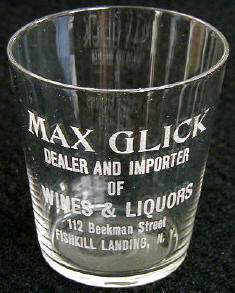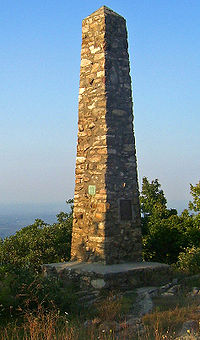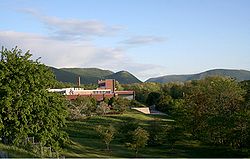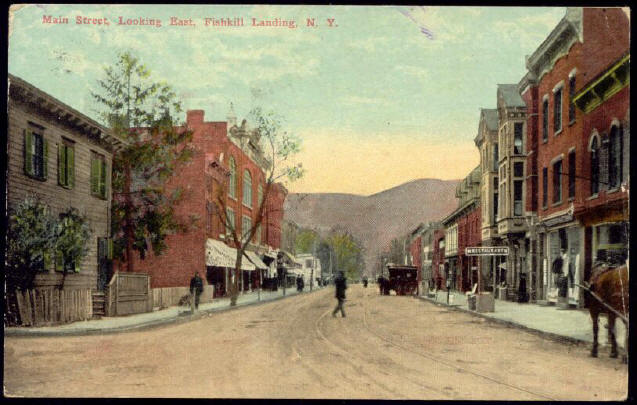|
In August of 2008 I
wrote a
column on a shot glass “one hit wonder.”
It seems to me
that it is time for another such article.
|
|
Fishkill Landing,
New York:
Another
“One Hit Wonder” |
|
|
There is only one glass attributed to Fishkill Landing, New York,
and that is a
“text only” glass featuring Max Glick, a “dealer and importer of
wines & liquors.”
The village of Fishkill Landing was located along the east bank of
the Hudson River, about fifty-nine miles north of New York City. It
was one of the original communities in the state, dating back to the
early 1700s. During the American Revolution, soldiers set signal
fires that blazed from the summit of Mount Beacon, alerting the
Continental Army about British troop movements. |
 |
In 1901 the local chapter of the Daughters of the American Revolution
erected a monument at the site of these fires, near the mountain’s
summit.
 During
the 1800s, the city became a factory town and was known as “The Hat
Making Capital of the United States,” with nearly fifty hat factories
operating at one time. In 1880 workmen discovered immense deposits of
clay, and a brickyard was established that lasted fifty years. During
the 1800s, the city became a factory town and was known as “The Hat
Making Capital of the United States,” with nearly fifty hat factories
operating at one time. In 1880 workmen discovered immense deposits of
clay, and a brickyard was established that lasted fifty years.
In 1910 the villages of Matteawan and Fishkill Landing voted to
consolidate as a new city. The March 26, 1910, issue of the New York
Times reported as follows:
“For fifty years the interests of both villages have been identical, and
at intervals the question of a merger has been submitted and defeated.
By today’s vote, however, not only do the separate identities of
Matteawan and Fishkill Landing cease, but both their names will
disappear from the map and a new name, not yet selected, will be chosen
hereafter.”
But why did the two villages vote to merge? The New York Times article
concludes by noting that the merger “is from a desire to be associated
no longer with Matteawan State Hospital for the Criminal Insane.”
The merger became effective three years later, in 1913. As predicted in
the New York Times of 1910, the names of the two villages disappeared,
to be replaced by a new name, “Beacon.” This name honors the beacon
fires that the soldiers set during the American Revolution.
The glass shown above is definitely a pre-prohibition glass. How do we
know? The Eighteenth Amendment (and with it, Prohibition), went into
effect in 1920.
The disappearance of Fishkill Landing in 1913 was seven years prior to
Prohibition. Thus, it seems reasonable to conclude that this glass can
be dated to a pre-pro time of 1913 or earlier.
 The
city of Beacon took an economic downturn that lasted from about 1970 to
the late 1990s, during which time almost eighty percent of the city’s
commercial business spaces and factories became vacant. But beginning in
the late 1990s, with the opening of one of the
world’s largest contemporary art
museums, Dia: Beacon, the city began an artistic and commercial
rebirth. The
city of Beacon took an economic downturn that lasted from about 1970 to
the late 1990s, during which time almost eighty percent of the city’s
commercial business spaces and factories became vacant. But beginning in
the late 1990s, with the opening of one of the
world’s largest contemporary art
museums, Dia: Beacon, the city began an artistic and commercial
rebirth.
Actor Robert Montgomery was born in Beacon, as was Notre Dame basketball
coach Digger Phelps. Actress Helen Hayes lived here, as did singer Pete
Seeger. A scene from the 2005 movie, War of the Worlds, was shot in
Beacon.
Max Glick’s store was on Beekman Street. This early view of Main Street
provides a good indication of what Beekman Street might have looked like
when Mr. Glick operated his business.

|

 During
the 1800s, the city became a factory town and was known as “The Hat
Making Capital of the United States,” with nearly fifty hat factories
operating at one time. In 1880 workmen discovered immense deposits of
clay, and a brickyard was established that lasted fifty years.
During
the 1800s, the city became a factory town and was known as “The Hat
Making Capital of the United States,” with nearly fifty hat factories
operating at one time. In 1880 workmen discovered immense deposits of
clay, and a brickyard was established that lasted fifty years. The
city of Beacon took an economic downturn that lasted from about 1970 to
the late 1990s, during which time almost eighty percent of the city’s
commercial business spaces and factories became vacant. But beginning in
the late 1990s, with the opening of one of the
The
city of Beacon took an economic downturn that lasted from about 1970 to
the late 1990s, during which time almost eighty percent of the city’s
commercial business spaces and factories became vacant. But beginning in
the late 1990s, with the opening of one of the
